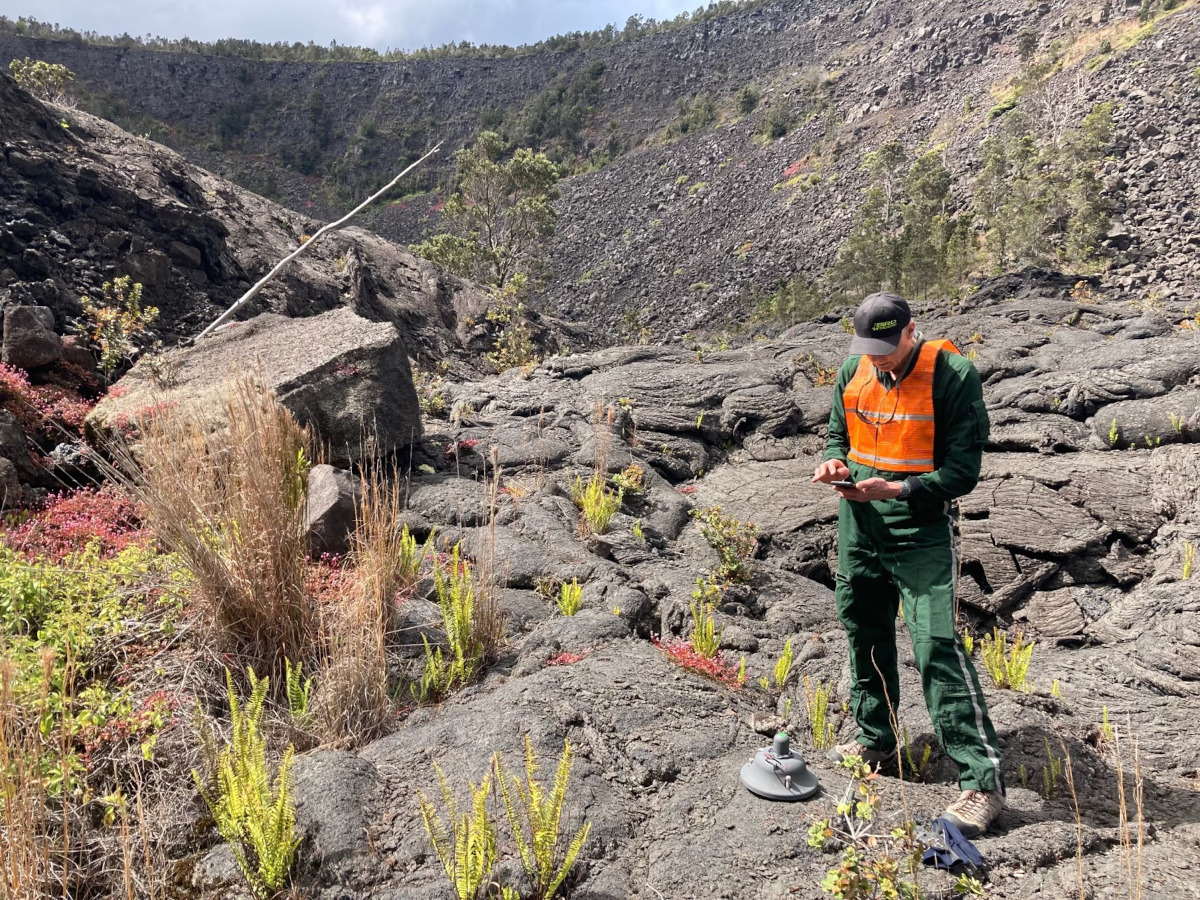
USGS: “A USGS scientist checks the location of the seismic node being installed within Pauahi Crater, in Hawaiʻi Volcanoes National Park, as part of the Kīlauea Seismic Imaging Project. The Hawaiian Volcano Observatory has a permanent monitoring network of several seismometers at the summit of Kīlauea that detect natural earthquakes, but more seismometers are needed to collect data at a higher resolution for this project. An additional 1,800 small earthquake-detecting devices, called seismic nodes, will be temporarily placed on the surface of Kīlauea’s summit region in the next two months.” (USGS image by M. Patrick)
(BIVN) – Kīlauea is not erupting, and remains at an alert level of ADVISORY. On Tuesday, the USGS Hawaiian Volcano Observatory posted its weekly update on the Hawaiʻi island volcano:
Activity Summary: Kīlauea volcano is not erupting. The summit eruption of Kīlauea volcano, within Halemaʻumaʻu crater, ended on March 7, 2023. Lava is no longer flowing on the crater floor. No significant changes have been observed at the summit or in either rift zone over the past week.
Summit Observations: Seismicity over the past week was at background levels, with a slight increase in earthquake counts beneath Kīlauea summit during two small earthquake swarms. Both swarms included approximately 30 microearthquakes (smaller than M2.0) detected over 12 hours at a depth of 0.5 mi (1 km) and were centered under Halemaʻumaʻu crater. The first swarm occurred on Thursday, April 13th, and the second swarm occurred on Sunday, April 16th. Sunday’s swarm progressed into slightly increased seismicity in the south caldera on Monday morning. Each swarm was associated with 2-3 microradians (urad) of inflation recorded on the Uēkahuna summit tiltmeter. All other summit monitoring data streams over the past week remain normal. Sulfur dioxide (SO2) emissions from the summit remain low; the most recent SO2 emission rate of approximately 110 tonnes per day (t/d) was measured on April 14.
Halemaʻumaʻu Lava Lake Observations: No active lava has been observed over the past week. A live-stream video of the inactive western lava lake area is available at (youtube.com).
East Rift Zone Observations: No unusual activity has been noted along the East Rift Zone or Southwest Rift Zone; steady rates of ground deformation and seismicity continue along both. Measurements from continuous gas monitoring stations downwind of Puʻuʻōʻō in the middle East Rift Zone remain below detection limits for SO2, indicating that SO2 emissions from Puʻuʻōʻō are negligible.
Hazard Analysis: The latest eruptive activity at Kīlauea’s summit occurred at the base of Halemaʻumaʻu crater, within the closed area of Hawaiʻi Volcanoes National Park. During Kīlauea summit eruptions, the high level of volcanic gas—primarily water vapor (H2O), carbon dioxide (CO2), and sulfur dioxide (SO2)—being emitted is the primary hazard of concern, as this hazard can have far-reaching effects downwind. Passive volcanic degassing can occur from within Halemaʻumaʻu crater even during periods of no eruptive activity. As SO2 is released from the summit, it reacts in the atmosphere to create the visible haze known as vog (volcanic smog) that has been observed downwind of Kīlauea. Vog creates the potential for airborne health hazards to residents and visitors, damages agricultural crops and other plants, and affects livestock. For more information on gas hazards at the summit of Kīlauea, please see (this publication). Vog information can be found at https://vog.ivhhn.org.
Other significant hazards also remain around Kīlauea caldera from Halemaʻumaʻu crater wall instability, ground cracking, and rockfalls that can be enhanced by earthquakes within the area closed to the public. This underscores the extremely hazardous nature of the rim surrounding Halemaʻumaʻu crater, an area that has been closed to the public since early 2008.

by Big Island Video News12:36 pm
on at
STORY SUMMARY
HAWAIʻI VOLCANOES NATIONAL PARK - Scientists tracked two earthquake swarms under Halemaʻumaʻu crater this week, and detailed the activity in a Tuesday update.